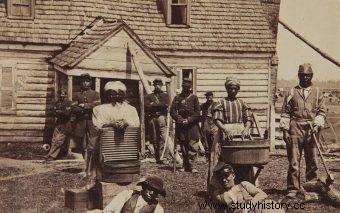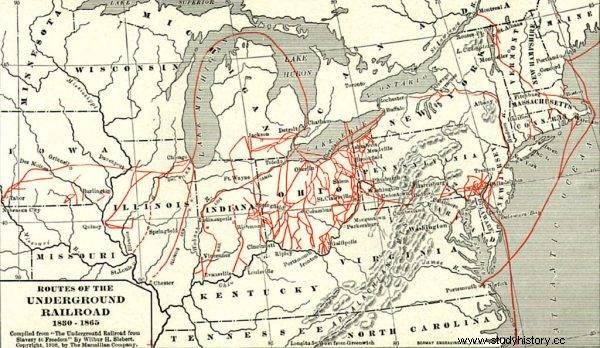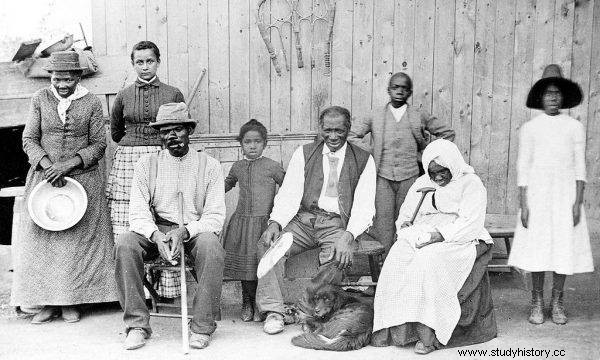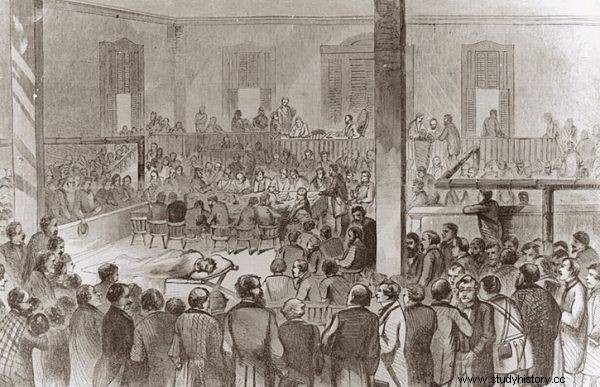The term Underground Railroad - that is, the underground railway - does not refer to tracks or carriages tied together running along routes hollowed out under the surface. It is a completely different composition, which, however, was also supposed to deliver the traveler to the destination station. It was liberation from slavery and full civil rights.
The underground railway consisted of all those who decided to help the slaves from the South, escaping en masse from hell of slavery to the dreamland of the Promised Land - in the northern states or in Canada, where they could live and work like white people, look them in the eyes, sit in train compartments next to them…

The Underground Railroad was the only chance for freedom for the refugee slaves from the American South.
Their path to freedom has often been a long wandering season, seasoned with pain, hunger, and fear. Each subsequent stop was another good man who co-created a specific relief network that stretched thousands of kilometers from the south to the north of the United States of America.
Solomon's solution
In 1850, the United States passed a law requiring citizens to hand over runaway slaves from the southern states to their owners. At the same time, the compromise bill to prevent the collapse of the Union and the civil war deprived black refugees of the right to a jury trial. The next compromise - and the separation of the US slavery frontier - became necessary when California, which wanted to be free from slavery, decided to join the EU. This, however, upset the balance between the slave and "free" states - so far there were 15 of them.
Ultimately, the Solomon solution was chosen. California was declared a slavery-free state, while leaving the issue open to Utah and New Mexico. On the other hand, in the capital district of Columbia, the slave trade was banned, but slavery as such was allowed.

Map of the conventional underground railway routes.
There was also the other pole of the "rotten compromise" - the legislator severely punished anyone who supported the refugees. You could be sent to prison for six months for helping fugitives. In addition, the rebellious citizens faced draconian financial penalties - $ 1,000 in fines from the state, but also $ 1,000 in damages for each slave assisted - paid to their owner.
The law, which further tightened the rules on fugitives, immediately sparked riots and outrage in the North. Rallies were held in Boston, New York and Chicago, where the city council issued a statement that the new law would be ignored by city officials. Congressmen voting for the compromise were insulted and called "Judas".
In turn, for supporters of maintaining slavery, the tightening of regulations was an ineffective, but the only form of fighting the mass exodus of black Americans to the North. On the way to freedom, which often - for fear of slave hunters - only ended in Canada, dozens of people helped them , the so-called abolitionists, offering accommodation and contacts, guiding at night through transit routes, organizing onward transport. This is how the underground railway operated in the United States in the mid-nineteenth century. It was here that the greatest fighters for racial equality got out of captivity.
Shepherds, conductors and governors
William Still, a black abolitionist and businessman from Pennsylvania, the son of a slave who managed to redeem himself from captivity at a potato and corn farm, is believed to be the father of the smuggling network and help runaway slaves. Still knew the taste of captivity and wandering perfectly well thanks to his mother, who ran away from the owner twice.
It was he who coined the concept of "underground railway". He was active in helping the refugees, dealt with their recording and gathering information about the route they traveled, difficulties they encountered, destination , needed for the later reunification of families, divided between plantation owners or during escapes. In Philadelphia he was involved in the activities of the Pennsylvaniaia Anti-Slavery Society.
In the Underground Railroad, he acted as a "conductor", which means in the Underground Raliway cipher, that he was a guide - he showed available routes, he knew where others were, he helped guide refugees through dangerous areas, organized transport and wrote coded letters. It is estimated that he helped hundreds of fugitives in this way. He hid many in his own home.

William Still was one of the fathers of the Underground.
The encrypted correspondence was full of railway vocabulary. Thus, in addition to the conductors, there were also "agents" or "shepherds" - that is, non-attached supporters of the abolition of slavery, who volunteered and spontaneously offered help. The hiding places of fugitives were called "stations", and abolitionists - "track". The "Zawiadowcy" are those who offered refugees accommodation under their own roof.
"Moses" or Captain Tubman
Perhaps the most famous human symbol of the underground railway, and at the same time its greatest heroine, was Harriet Tubman, a slave girl who survived hell but managed to get out of it - and pull a lot of people out of it. Jill Lepore, author of the book We, the nation. A New History of the United States ”writes:
Harriet Tubman ran away for the first time when she was only 7 years old (...) being only 152 centimeters tall, she was beaten and starved - a heavy object pressed against her left in her skull cavity - however, she escaped from captivity in 1849, fleeing Maryland to Philadelphia.
Beginning in 1850, made at least 13 trips to Maryland, saving approximately 70 men, women and children. At that time, she worked in New York as a laundress, housekeeper and cook. People started calling her "Captain Tubman" or just "Moses." When asked once what she would do if she were caught, she replied:"I am comforted that I did something good for my people" .

Harriet Tubman with family and rescued slaves.
Tubman (original name Araminta Ross) was born in captivity in Maryland. From childhood, she worked beyond her strength, was whipped and abused in various ways for the smallest offenses. The tiny woman was doing extremely hard work - she was plowing the field, packing and transporting the crops from the plantations. She only drew hope from deep faith. She was convinced that God had set a target for her, as was for Moses who led his people out of Egyptian land.
In 1849 she successfully managed to escape, among others thanks to the help of the Quaker community - white settlers, abolitionists and pacifists, deeply religious Christians who emphasize the value of direct communication with God. After 1850, when the penalties for fleeing and helping slaves were tightened in the USA, Harriet - despite personal failures (she learned of her husband's betrayal and his remarriage in her absence) - decided to return to the South to work in the Underground Railroad.
Citizen John Brown
Another icon of the abolitionist movement in the US was John Brown, who was extremely fierce in his fight against slavery, seeing the growers of slave labor as bandits. Brown was a supporter of active struggle. In May 1856, during the so-called fights in Kansas, i.e. bloody clashes between supporters and opponents of slavery, together with his sons personally murdered 5 farmers , settlers from the North who were advocates of free black labor.
In 1859, Brown tried to enlist the support of Harriet Tubman and Frederick Douglass for further armed struggle - one of the leaders of the movement who also escaped from captivity using the Underground Railroad. However, he did not succeed. For African American railroad activists, Brown's behavior was too radical.

The John Brown Trial
Soon after, on October 16, 1859, John Brown and armed men subordinate to him tried to start an uprising in Virginia. He managed to seize an arsenal with weapons, free slaves from several plantations, and take their owners hostage. The action did not, however, become as dynamic as the spurt.
Soon the army pacified Brown and his men. The abolitionist leader himself was sentenced to death. The sentence was carried out - despite protests from all over the world (even before his death, the poem To Citizen John B. our bard, Cyprian Kamil Norwid, added to his letter to the Polish diaspora in America). Brown's death was one of the casus belli . Soon after, the United States plunged into the depths of a civil war.
Amendment 13
Harriet Tubman became a legend in her lifetime. In 1861, during the Civil War, she served as a nurse in the Union army. She has helped hundreds of people. But that was not the end of her calling. Providence set her one more task. In 1863, she became the first woman in the history of the Civil War to lead an expedition of 150 African-American soldiers from the 54th Massachusetts Infantry Regiment and participated in the release of 750 slaves during an air raid on the Combahee Ferry.
The 13th Amendment to the US Constitution passed in 1865 says that: "slavery ... will not exist within the United States or anywhere under its jurisdiction" . Thus, 4 million African Americans have been recognized as US citizens.
The heroine of the fight for freedom managed to make a life for herself, although Harriet's new, free world was not dotted with roses. She struggled with prejudice and discrimination. She also struggled with the ghosts and physical pain of the past. Childhood fractures resulted in continuous, long-term migraines and seizures. Despite this, she managed to start a family again - she got married, adopted a daughter.
She was also involved in freedom activities until the end of her life. She supported the suffragette movement and donated a plot of land she had bought in Pennsylvania to build a retirement home. She died in 1913. She was buried with military honors at Fort Hill Cemetery in Auburn. To this day, it is one of the symbols of freedom movements around the world. Harriet Tubman's rich biography has been captured on the big screen. The movie Harriet based on her biography directed by Kasia Lemmons, it premiered in 2019.
In 2004, the subway itself was commemorated - the National Underground Railroad Freedom Center was opened in Cincinnati, Ohio - a museum for the history of helping refugees from the slave South, but also the entire abolitionist movement that led to the liberation of millions of US citizens.
Bibliography:
- Ira Berlin, Generations in captivity. A History of Slavery in North America , PIW 2010.
- Jean Humez, Harriet Tubman:The Life and Life Stories , Madison:University of Wisconsin Press. 2003.
- Leon Korusiewicz, Causes of the American Civil War , PWN 1967.
- Jill Lepore, We the people. New History of the United States , Poznań Publishing House 2020.
- Wiktor Osiatyński, The Evolution of American Social and Political Thought , Warsaw 1983.
- Michał Rozbicki, Birth of the nation. History of the United States until 1861 , Warsaw 1991.
- Wacław Szyszkowski, The fight for the civil rights of the Negro people in the United States , Toruń, TNT 1966.
- Paweł Zaremba, History of the United States , Warsaw 1992.
